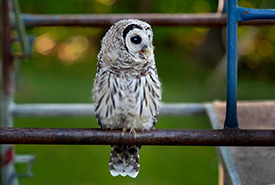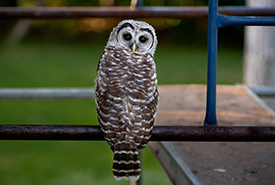And owl…will always…love you!

A barred owl perched on scaffolding on a roof that’s being re-done. (Photo by Rebecca Clarke)
As an avid nature lover, I am constantly in awe of the beauty and diversity of the natural world, but there's one species that holds a special place in my heart: barred owl. Have you ever heard the distinctive call of a barred owl at night and felt a shiver of excitement run down your spine? These magnificent birds of prey are known for their haunting “Who-cooks-for-you, who-cooks-for-you-all” call. In a previous post, I was lucky enough to observe barred owl snow angels in northern Manitoba.
In 2019 when my family made the move to Nova Scotia, I was excited about the prospect of new species to discover but nothing beat the feeling of being in my backyard that first night and hearing barred owls calling.
Barred owls are native to North America and are found in a variety of habitats, including forests, swamps and even suburban areas. Barred owls are powerful hunters, feeding on a variety of prey including mice, squirrels and even other birds. Spotting and hearing owls is best done during early morning or late evening hours when they are most active, but they can be observed any time of the day. With a little detective work and some patience, you can often follow barred owl calls to find them perching in high places, like trees, and even human-made structures, like scaffolding, as observed by my neighbour, friend and photographer Rebecca one evening from her house.

The inquisitive owl is just as curious about the cyclops (camera lens) staring right back at it. (Photo by Rebecca Clarke)
Owl-watching tips
If barred owls live in your area and you want to see them closer to home, you need to set the stage for success by making your yard a haven for wildlife. This means planting native trees and shrubs, especially ones with berries and other food sources, and installing nesting boxes. These little touches will give the owls (and other critters) a place to call home and provide them with the resources they need to thrive. Avoid using any pesticides, herbicides and especially rodenticide chemicals, as you could poison owls looking for a snack.
The most important factor to consider before making improvements is if your area is safe for owls. Attracting owls to an unsafe location is unethical and wrong. No matter how badly you'd like to watch owls near you, the well-being of the birds must be the number one priority. Never bait owls; it can disrupt their natural feeding habits and make them dependant on humans. If you live somewhere where seeing owls from home is unlikely or not a safe space, you can go owl watching in other areas. This could include local hiking trails, parks and taking drives in the country during sunrise/sunset. Follow best practices to keep yourself safe. Or better yet get involved with local birdwatching or naturalist group to go with other enthusiasts.
The excitement you'll feel when you finally spot a barred owl (and other wildlife) is unbeatable. The best part is that this is a family-friendly activity that everyone can enjoy! Take the kids and turn it into a fun nature adventure. Teach them about these incredible birds and the role they play in our ecosystem. My children love the thrill of hearing a barred owl call and searching for these mysterious creatures, and I love that nature can be found in my own back yard.
Check out these Small Acts of Conservation and find out which small-scale efforts that can provide a positive benefit for wildlife and their habitats across the country is right for you.


